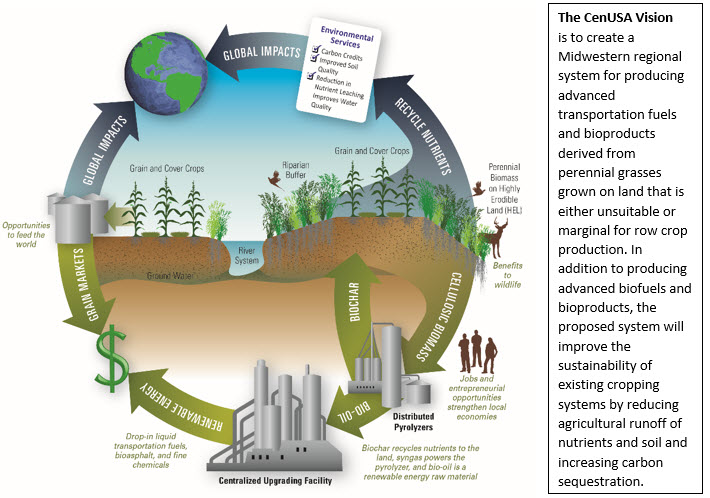CenUSA’s System Performance team research shows water quality benefits when biofuels are produced from perennial grasses; provides guidance for policymakers, farmers, and the bioenergy industry.
Sponsoring Partner

Funded by AFRI. Learn More.
Table of Contents
- The Team and Objectives
- Team Activities
- Outcomes from The Team’s Work
- Why This Work Is Important
- Contributors to This Report
- CenUSA Feedstock Development Team Publications

The Team and Objectives
Despite more than 40 years of largely voluntary efforts by federal, state and local government, and tens of billions of dollars of investment in conservation, nationwide progress on nutrient control has not yet been achieved. Concentrations of nitrogen (N) and phosphorus (P) in streams and groundwater are 2-10 times higher than recommended to protect aquatic life and contamination of drinking water is still widespread. The consequences of agricultural nonpoint source pollution are particularly evident where the Mississippi River enters the Gulf of Mexico. The Gulf’s hypoxic, or “dead zone” is the largest hypoxic region in the US and the second largest in the world.

CenUSA’s System Performance team jointly led by Iowa State University’s Cathy Kling and the University of Minnesota’s Jason Hill has focused on water quality and biofuel production life cycle analysis. Kling’s Iowa State team has worked to develop models that could evaluate what is likely to happen to water quality with various biofuel scenarios and help guide policymakers, farmers, and the bioenergy industry in designing sustainable regional biofuels systems. Their cutting edge work compared different bioenergy feedstocks, grown in both marginal and prime farmland, and how new biomass production systems are likely to impact water quality and climate change.
“CenUSA is a large project working to evaluate the production of perennial biofuels in the Corn Belt, said System Performance team collaborator Phil Gassman of Iowa State University. “We’ve been working with people across many institutions and have been fortunate to develop a tight collaboration with a great group of scientists.”
Team Activities
 Three papers co-authored by Kling and Gassman along with other team members Indrajeet Chauby (Purdue University), Raj Cibin (Penn State) and Yiannis Panagopoulus (formerly a post doc at Iowa State now at National Technical University, Athens, Greece) have recently been accepted by or are in review with the Journal of American Water Resources Association (JAWRA). A fourth overview paper, currently accepted by JAWRA, “Policy Implications from Multi-Scale Watershed Models of Biofuel Crop Adoption across the Corn Belt,” compares the findings from these three studies and discusses policy impacts.
Three papers co-authored by Kling and Gassman along with other team members Indrajeet Chauby (Purdue University), Raj Cibin (Penn State) and Yiannis Panagopoulus (formerly a post doc at Iowa State now at National Technical University, Athens, Greece) have recently been accepted by or are in review with the Journal of American Water Resources Association (JAWRA). A fourth overview paper, currently accepted by JAWRA, “Policy Implications from Multi-Scale Watershed Models of Biofuel Crop Adoption across the Corn Belt,” compares the findings from these three studies and discusses policy impacts.
The team’s research addresses one of the country’s key policy questions, what are the water quality impacts of converting cropland and/or marginal lands to cellulosic biofuel systems in the upper Midwest? Uniquely, their models compared land use changes at different scales: within three smaller watersheds, the Boone River Basin in Iowa and the Wildcat Creek Basin and St Joseph River Basin in Indiana and at a larger scale, using a regional model developed across the Upper Mississippi and Ohio Tennessee watersheds (Figure 1).
Outcomes from The Team’s Work
To contrast results across the models, the team developed a set of scenarios, using the most promising biofuel feedstocks: corn stover, switchgrass and miscanthus; grown at different intensities (Corn stover harvested at 20% and 50% removal rates; and miscanthus and switchgrass grown in all cropland of the watershed versus targeted regions, environmental sensitive areas (lands greater than 2% slope) (Table 1). Results showed major environmental improvements from planting perennials, and that targeting their conversion on marginal lands can result in a disproportionately bigger impact. In general, and perhaps surprisingly, corn stover removal had small negative impacts on environmental losses. The modeled results may lead biofuel policy toward utilizing both corn stover and perennial grasses, targeted to marginal lands; something the authors state could be a potential “win-win.”

Why This Work Is Important
“Our results confirmed what field studies and previous modeling studies have shown,” said Gassman. “Working perennials into agricultural landscapes has big benefits. Perennial feedstocks have huge impacts in reducing pollutant losses,” said Gassman.
In the latest JAWRA paper, the authors explain that, “there is a clear evidence that there are gains from targeting perennials to marginal land.” Watershed scale modeling of the type done by the CenUSA team, “can provide useful information to policy makers concerning the environmental gains from adopting changes in the existing [CRP] program or develop new options in the future…”
The water quality benefits of perennials reported in these studies may encourage policy makers to reconfigure federal agriculture and energy policies including the Renewable Fuel Standard (RFS) and USDA conservation programs like the Conservation Reserve Program (CRP), Environmental Quality Incentive Program (EQIP) and Conservation Security Program (CSP) to utilize corn stover on prime acres along with perennial grasses, targeted to marginal lands; something the authors state could be a potential “win-win.”
Rather than paying farmers to set land aside, policy makers, particularly those looking at budget impacts, may see a benefit from programs that allow corn (grain and stover) to be harvested on prime lands while aiming perennials on marginal lands. If farmers were paid to plant perennial crops like switchgrass and the crops could be harvested, federal rental payments for conservation programs like CRP could be lowered to reflect the commercial benefit provided to growers. Similarly, the Hypoxic Task Force, with its goal of state nutrient plans reducing nutrient loads by 45% may see an opportunity in exploring the role of perennials and biofeedstock production in the Mississippi River watershed.
Contributors to This Summary
Author: Pamela Porter, Environmental Resources Center, University of Wisconsin
CenUSA Feedstock Development Team Publications
CenUSA Project Resources – information on the opportunities and challenges in developing a sustainable system for the thermochemical production of biofuels from perennial grasses grown on land marginal for row crop production.
Case Study
Fact Sheets
- Estimated Cost of Establishment and Production of “Liberty” Switchgrass: Perennial Grass Decision Support Tool – Mainul Hoque, Georgeanne Artz, Chad Hart
- The Economics of Switchgrass for Biofuel – Richard Perrin
Research Summaries
- Competition For Land Use: Why Would a Rational Producer Grow Switchgrass for Biofuel? – Keri Jacobs
- Management Practices Impact Greenhouse Gas Emissions in the Harvest of Corn Stover for Biofuels – Virginia Jin
- Minnesota Watershed Nitrogen Reduction Planning Tool – Bill Lazarus
Curriculum
- Developing a New Supply Chain for Biofuels: Contracting for Dedicated Energy Crops – Corinne Alexander
Webinars
- Competition for Land Use: Why would the rational producer grow switchgrass for biofuel? – Keri Jacobs
- Diversifying Cellulosic Feedstocks – DK Lee
- Perennial Herbaceous Biomass Biomass Production and Harvest in the Prairie Pothole Region of the Northern Great Plains – Susan Rupp
- Switchgrass Cost of Production – Marty Schmer
- Switchgrass Economics in the North Central Region of the USA (Captioned) – Richard Perrin
Instructional Video
- Enhancing the Mississippi Watershed with Perennial Bioenergy Crops – Pam Porter
- Role of Biochar in Achieving a Carbon Negative Economy – David Laird
FAQs (Frequently Asked Questions)
- What effects do corn stover removal rates have on greenhouse gas emissions from cropland?
- Can the use of conservation tillage help reduce greenhouse gas emissions from cropland soils where residues are used for biofuel?
Journal Publications
- Schmer MR, Vogel KP, Varvel GE, Follett RF, Mitchell RB, et al. (2014) Energy Potential and Greenhouse Gas Emissions from Bioenergy Cropping Systems on Marginally Productive Cropland. PLoS ONE 9(3): e89501. DOI: 10.1371/journal.pone.0089501
- Schilling, K., Gassman, P., Kling, C. T. Campbell, M. Jha, C. Wolter, & J. Arnold. (2103). The Potential for Agricultural Land Use Change to Reduce Flood Risk in a Large Watershed. Hydrological Processes (2013), wileyonlinelibrary.com, DOI: 10.1002/hyp.9865.
- Rabotyagov, S., Kling, C.L., Gassman, P., Rabalais, N. & Turner, R. (2014). The Economics of Dead Zones: Causes, Impacts, Policy Challenges, and a Model of the Gulf of Mexico Hypoxic Zone. Review of Environmental Economics and Policy, published online Jan. 5, 2014 DOI:10.1093/reep/ret024
- Keeler B., Krohn, B., Nickerson, T. & Hill, J. (2014). U.S. Federal agency models offer different visions for achieving Renewable Fuel Standard (RFS2) biofuel volumes. Environ. Sci. Technol. (2013) 47: 10095–10101. DOI: 10.1021/es402181y. (Cover Feature)
- Panagopoulos, Y., Gassman, P., Arritt, R., Herzmann, D., Campbell, T., Jha, M., Kling, C.L., Srinivasan, R., White, M. & Arnold, J. (2014). Surface Water Quality and Cropping Systems Sustainability under a Changing Climate in the Upper Mississippi River Basin. Journal of Soil and Water Conservation 69:483-494. DOI: 10.2489/jswc.69.6.483.
- Rabotyagov, S., Valcu, A. & Kling, C.L. (2014). Reversing the Property Rights: Practice-Based Approaches for Controlling Agricultural Nonpoint-Source Water Pollution When Emissions Aggregate Nonlinearly. American Journal of Agricultural Economics 96 (2): 397-419. DOI 10.1093/ajae/aat094.
CenUSA Bioenergy is a coordinated research and education effort investigating the creation of a regional system in the Central US for producing advanced transportation fuels from perennial grasses on land that is either unsuitable or marginal for row crop production.* In addition to producing advanced biofuels, the proposed system will improve the sustainability of existing cropping systems by reducing agricultural runoff of nutrients in soil and increasing carbon sequestration.
CenUSA is supported by Agriculture and Food Research Initiative Competitive Grant no. 2011-68005-30411 from the USDA National Institute of Food and Agriculture.

